Abstract
OBJECTIVE: To present current strategies for the treatment of hemophilia and von Willebrand's disease. OPTIONS: Prophylactic and corrective therapy with hemostatic and adjunctive agents: DDAVP (1-desamino-8-D-arginine vasopressin [desmopressin acetate]), recombinant coagulation products (human Factor VIII and human Factor VIIa) or virally inactivated plasma-derived products (high- or ultra-high-purity human Factor VIII or human Factor VIII concentrate containing von Willebrand factor activity, porcine Factor VIII, high-purity human Factor IX, human prothrombin-complex concentrate, human activated prothrombin-complex concentrate), adjunctive antifibrinolytic agents, topical thrombin and fibrin sealant. The induction of immune tolerance in patients in whom inhibitors develop should also be considered. OUTCOMES: Morbidity and quality of life associated with bleeding and treatment. EVIDENCE: Relevant clinical studies and reports published from 1974 to 1994 were examined. A search was conducted of our reprint files, MEDLINE, citations in the articles reviewed and references provided by colleagues. In the MEDLINE search the following terms were used singly or in combination: "hemophilia," "von Willebrand's disease," "Factor VIII," "Factor IX," "von Willebrand factor," "diagnosis," "management," "home care," "comprehensive care," "inhibitor," "AIDS," "hepatitis," "life expectancy," "complications," "practice guidelines," "consensus statement" and "controlled trial." The in-depth review included only articles written in English from North America and Europe that were relevant to human disease and pertinent to a predetermined outline. The availability of treatment products in Canada was also considered. VALUES: Minimizing morbidity and maximizing functional status and quality of life were given a high value. BENEFITS, HARMS AND COSTS: Proper prophylactic or early treatment with appropriate hemostatic agents minimizes morbidity and functional disability and improves quality of life. Economic gains are realized through the reduction of mortality and morbidity and their associated costs. The patient has a better opportunity to contribute to society through gainful employment and the fulfillment of social roles. Potential harms include HIV infection, hepatitis B, hepatitis C and the development of inhibitor antibodies to clotting-factor concentrates. The risk of viral transmission has been minimized through the development of procedures for the viral inactivation of plasma-derived clotting-factor concentrates and through the use of recombinant coagulation-factor concentrates and other non-plasma-derived hemostatic agents. RECOMMENDATIONS: DDAVP is the drug of choice for patients with mild hemophilia or type 1 or 2 (except 2B) von Willebrand's disease whose response to DDAVP in previous testing has been found to be adequate. Therapeutic blood components of choice include recombinant products and virally inactivated plasma-derived products. In Canada the recommended products are recombinant Factor VIII for hemophilia A, high-purity plasma-derived Factor IX for hemophilia B and plasma-derived Factor VIII concentrates containing adequate von Willebrand factor (e.g., Haemate P) for von Willebrand's disease. Dosages vary according to specific indications. Adjunctive antifibrinolytic agents, topical thrombin and fibrin sealant are useful for the treatment of oral or dental bleeds and localized bleeds in accessible sites. In patients with inhibitor antibodies, high-dose human or porcine Factor VIII is usually effective when the inhibitor titre is less than 5 Bethesda units/mL. In nonresponsive patients, or in those whose inhibitor titre is higher, "bypassing" agents (e.g., activated prothrombin-complex concentrate and recombinant Factor VIIa) are useful. Long-term management may include immune-tolerance induction.VALIDATION: These recommendations were reviewed and approved by the Association of Hemophilia Clinic Directors of Canada (AHCDC) and the Medical and Scientific Advisory Committee of the Canadian Hemophilia Society. No similar consensus statements or practice guidelines are available for comparison. SPONSORS: These recommendations were developed at the request of the Canadian Blood Agency, which funds the provision of all coagulation-factor concentrates for people with congenital bleeding disorders, and were developed and endorsed by the AHCDC and the Medical and Scientific Advisory Committee of the Canadian Hemophilia Society.
Full text
PDF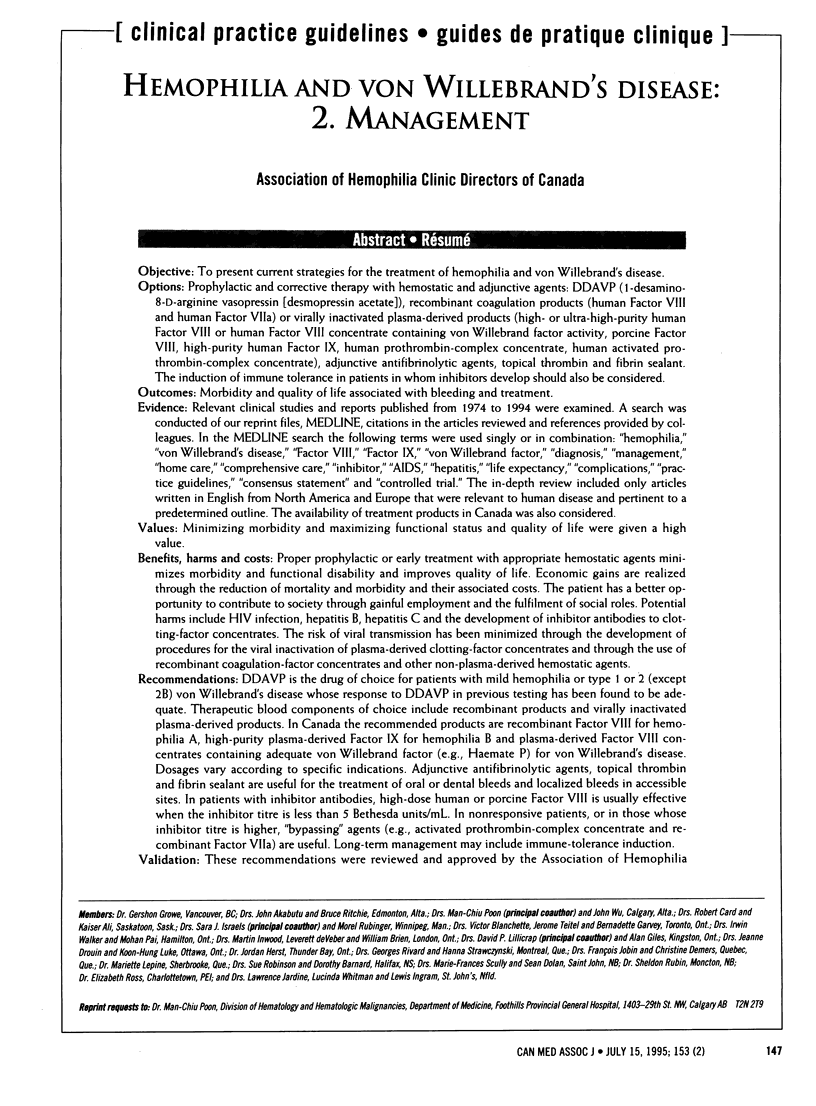

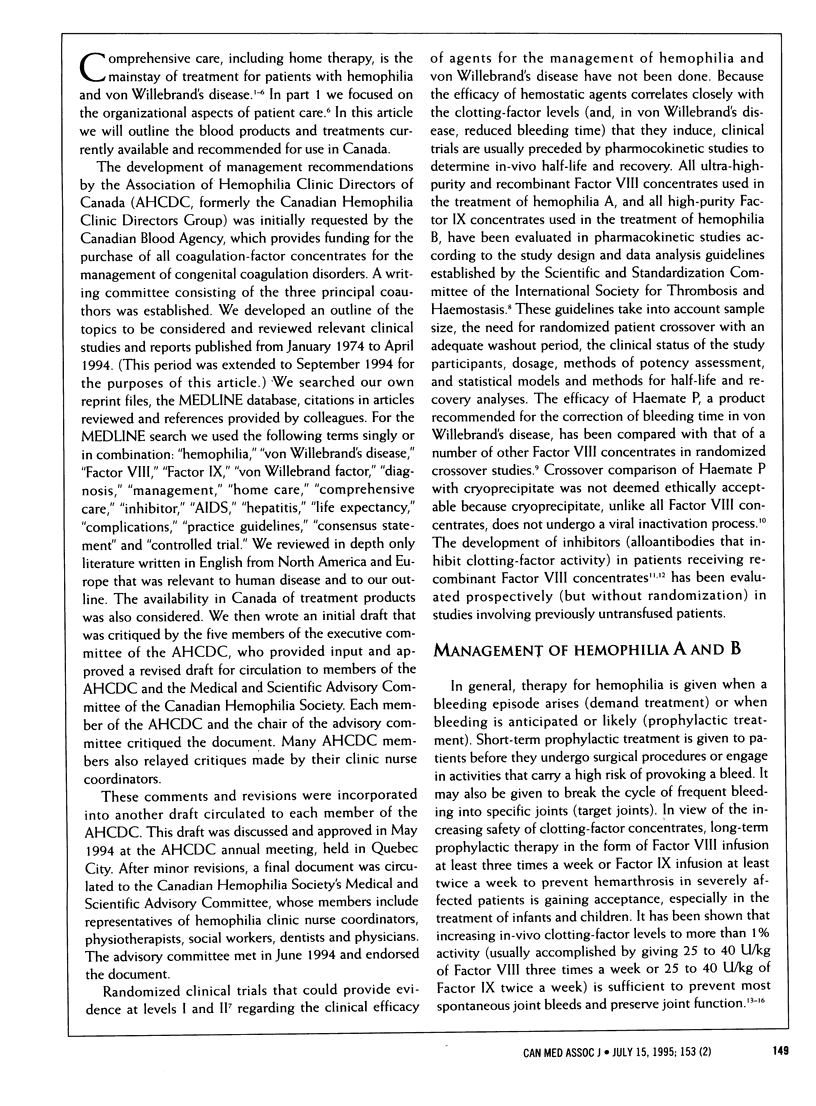
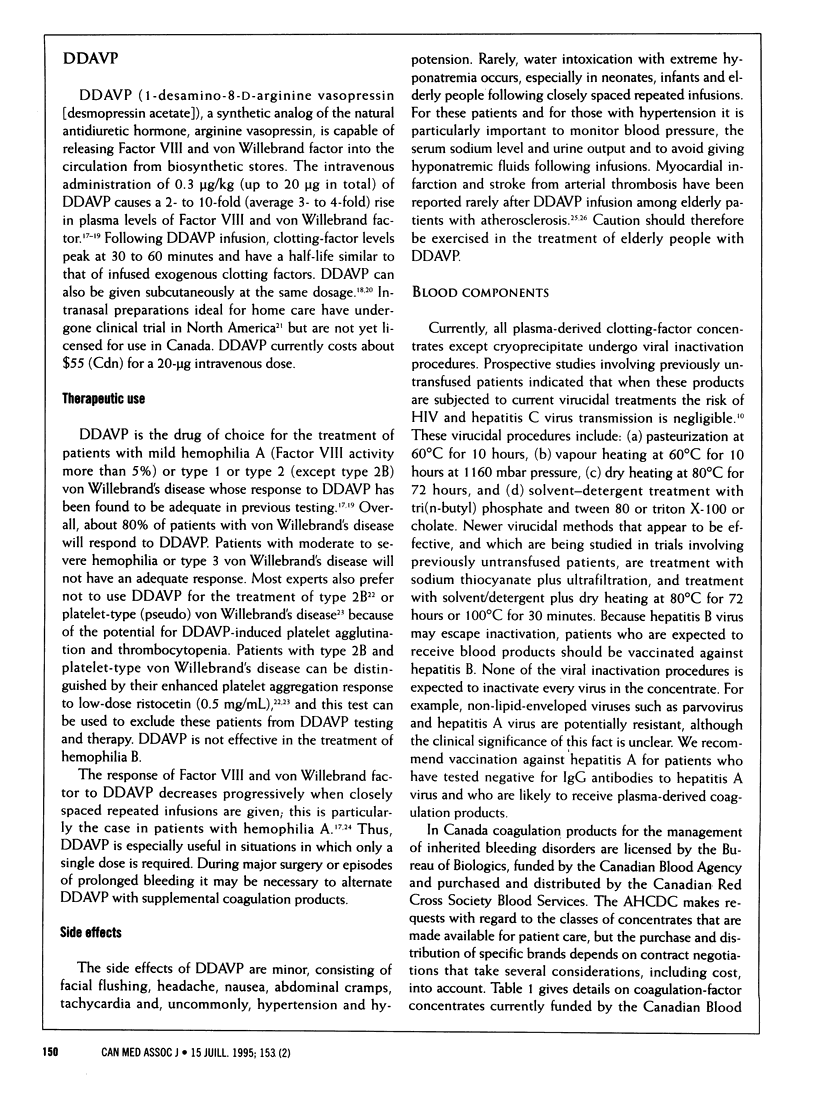
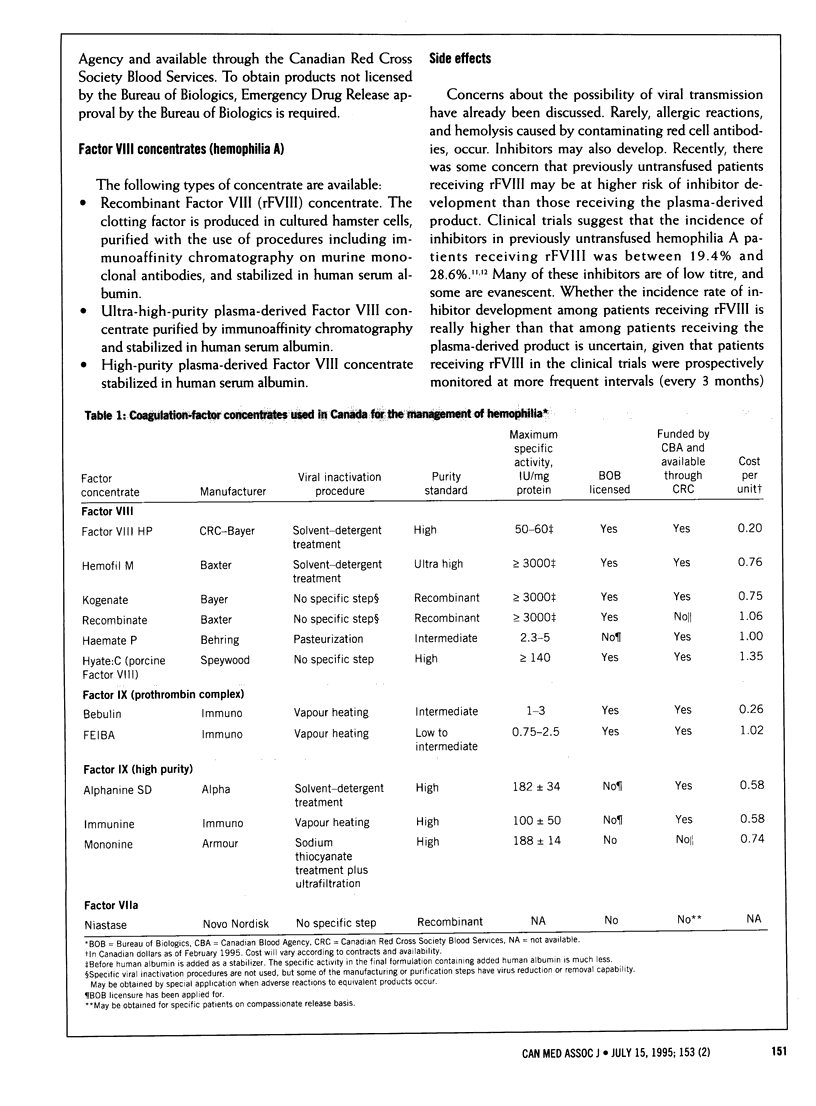
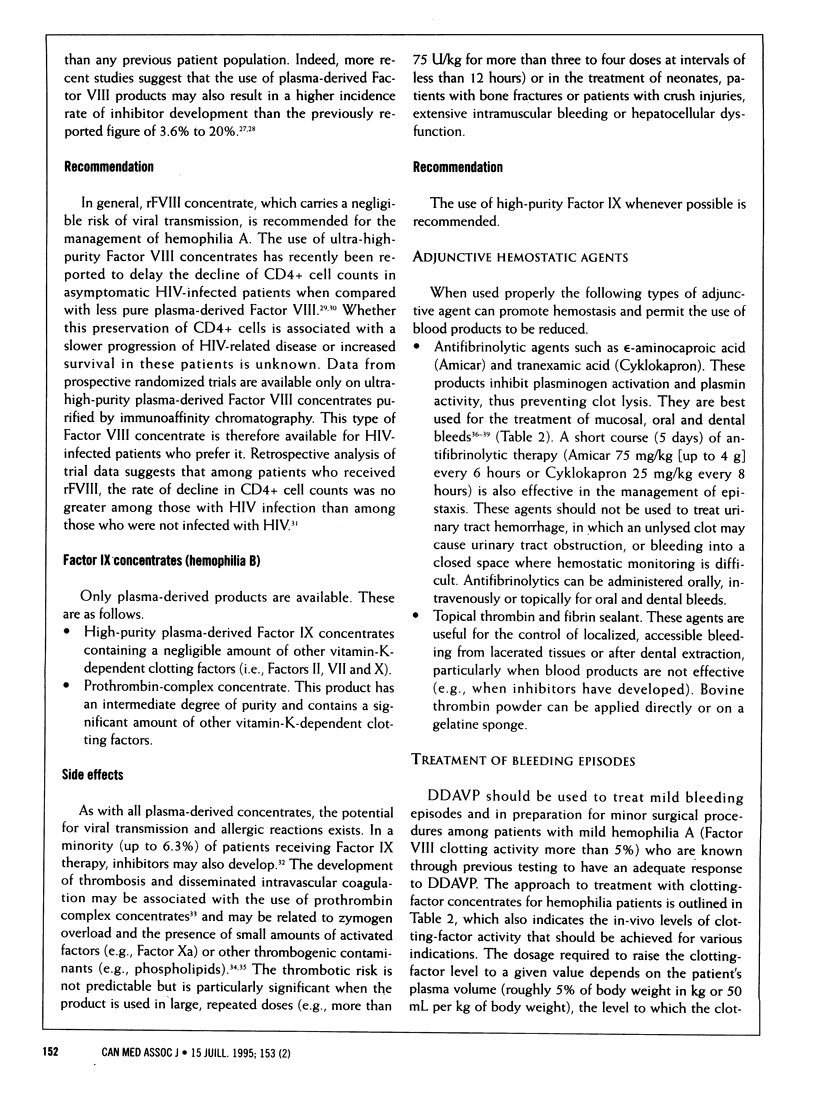
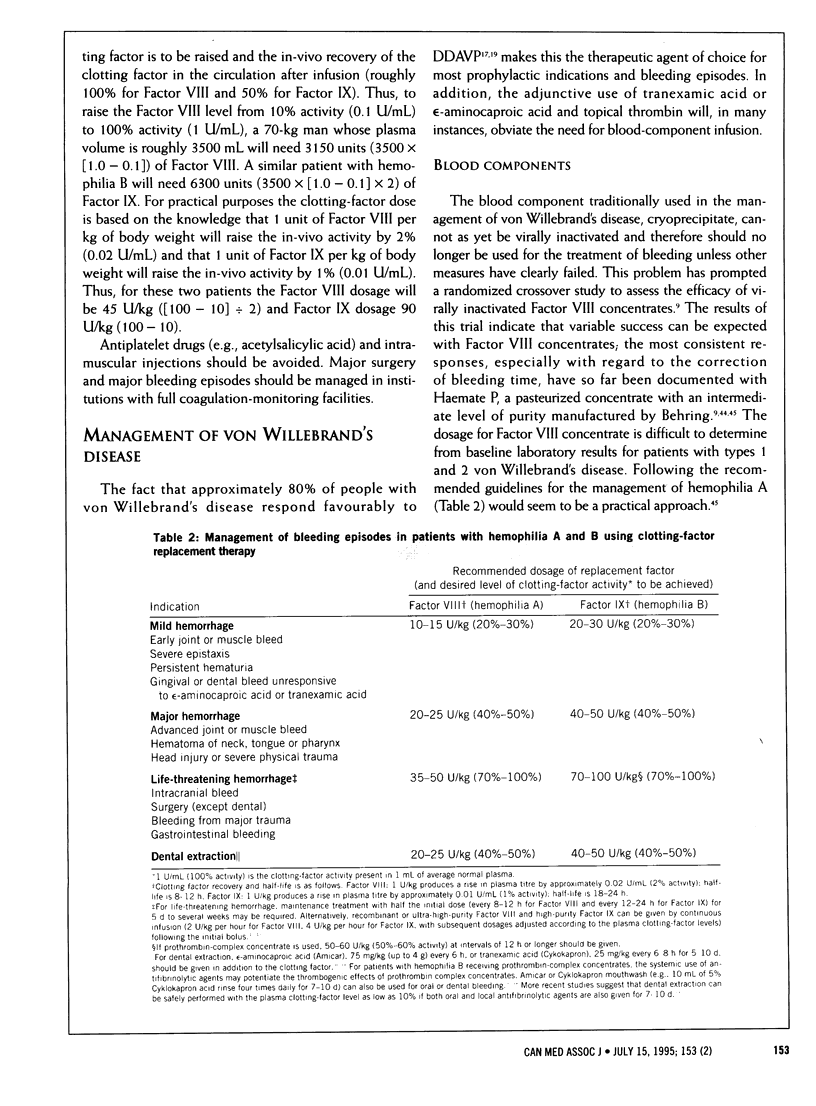
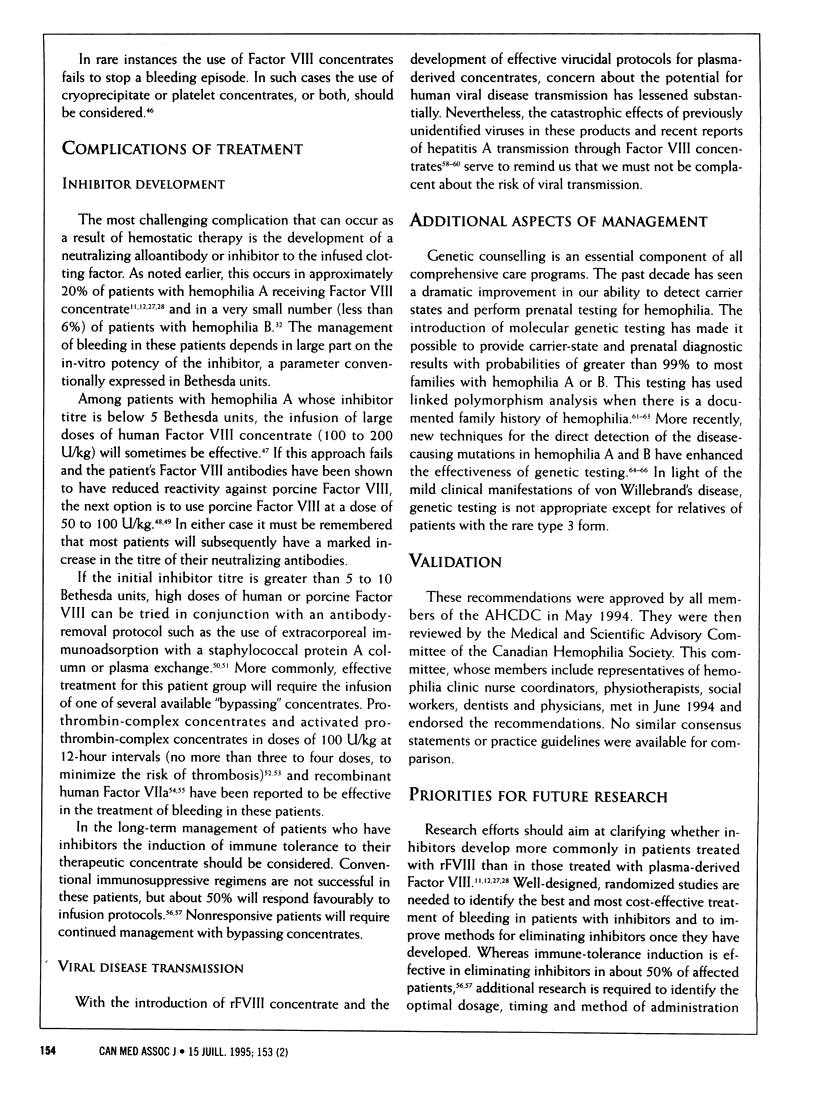
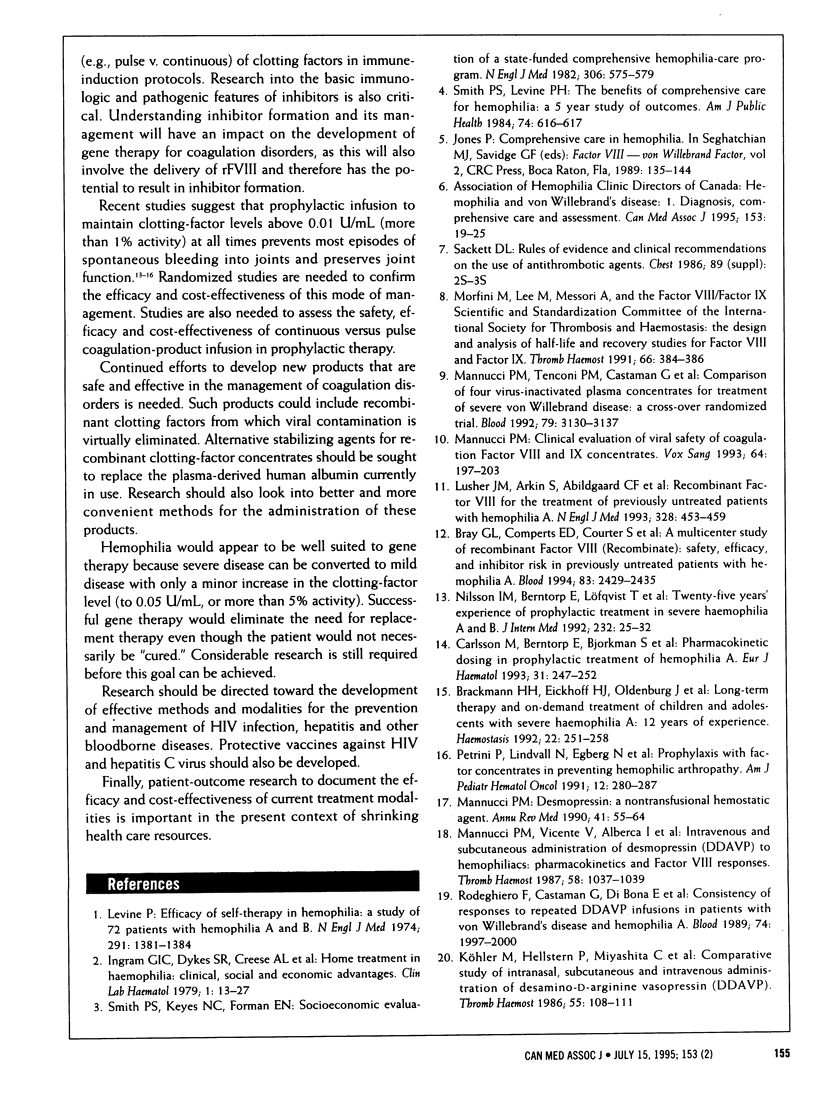

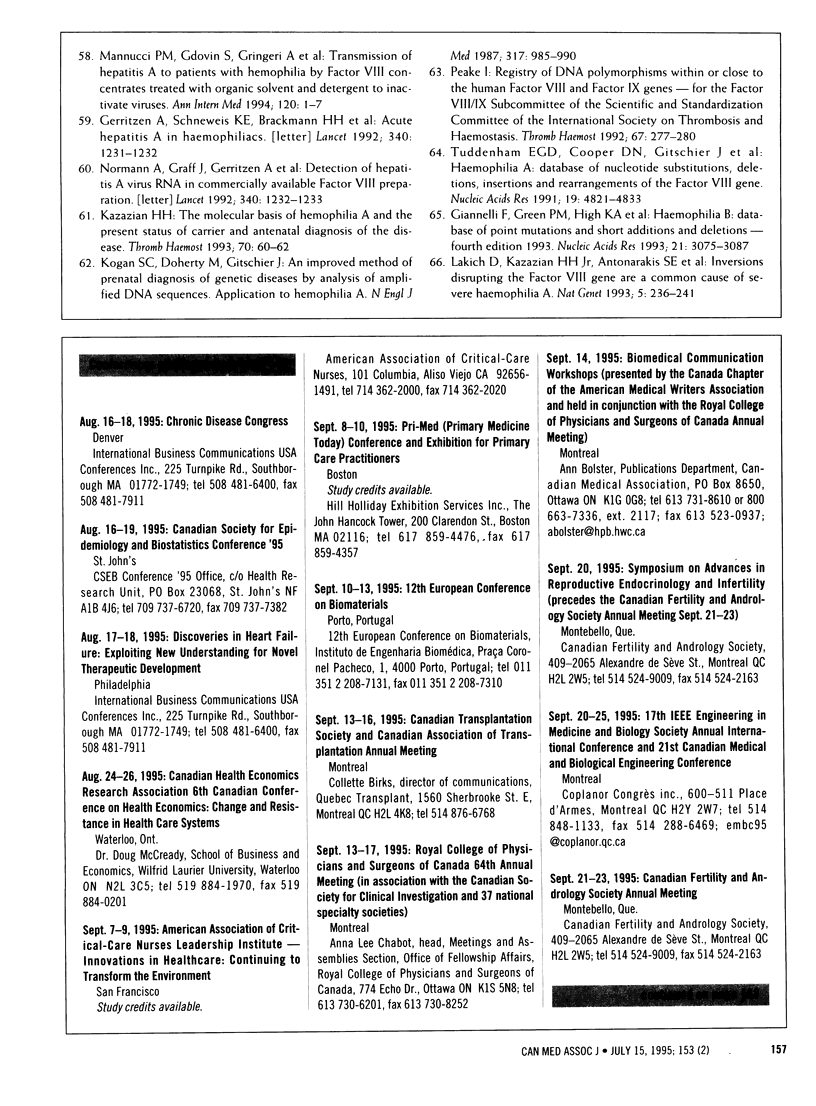
Selected References
These references are in PubMed. This may not be the complete list of references from this article.
- Addiego J., Kasper C., Abildgaard C., Hilgartner M., Lusher J., Glader B., Aledort L. Frequency of inhibitor development in haemophiliacs treated with low-purity factor VIII. Lancet. 1993 Aug 21;342(8869):462–464. doi: 10.1016/0140-6736(93)91593-b. [DOI] [PubMed] [Google Scholar]
- Berntorp E., Nilsson I. M. Use of a high-purity factor VIII concentrate (Hemate P) in von Willebrand's disease. Vox Sang. 1989;56(4):212–217. doi: 10.1111/j.1423-0410.1989.tb02031.x. [DOI] [PubMed] [Google Scholar]
- Bona R. D., Weinstein R. A., Weisman S. J., Bartolomeo A., Rickles F. R. The use of continuous infusion of factor concentrates in the treatment of hemophilia. Am J Hematol. 1989 Sep;32(1):8–13. doi: 10.1002/ajh.2830320103. [DOI] [PubMed] [Google Scholar]
- Brackmann H. H., Eickhoff H. J., Oldenburg J., Hammerstein U. Long-term therapy and on-demand treatment of children and adolescents with severe haemophilia A: 12 years of experience. Haemostasis. 1992;22(5):251–258. doi: 10.1159/000216332. [DOI] [PubMed] [Google Scholar]
- Bray G. L., Gomperts E. D., Courter S., Gruppo R., Gordon E. M., Manco-Johnson M., Shapiro A., Scheibel E., White G., 3rd, Lee M. A multicenter study of recombinant factor VIII (recombinate): safety, efficacy, and inhibitor risk in previously untreated patients with hemophilia A. The Recombinate Study Group. Blood. 1994 May 1;83(9):2428–2435. [PubMed] [Google Scholar]
- Brettler D. B., Forsberg A. D., Levine P. H., Aledort L. M., Hilgartner M. W., Kasper C. K., Lusher J. M., McMillan C., Roberts H. The use of porcine factor VIII concentrate (Hyate:C) in the treatment of patients with inhibitor antibodies to factor VIII. A multicenter US experience. Arch Intern Med. 1989 Jun;149(6):1381–1385. [PubMed] [Google Scholar]
- Carlsson M., Berntorp E., Björkman S., Lindvall K. Pharmacokinetic dosing in prophylactic treatment of hemophilia A. Eur J Haematol. 1993 Oct;51(4):247–252. doi: 10.1111/j.1600-0609.1993.tb00638.x. [DOI] [PubMed] [Google Scholar]
- Castillo R., Monteagudo J., Escolar G., Ordinas A., Magallón M., Martín Villar J. Hemostatic effect of normal platelet transfusion in severe von Willebrand disease patients. Blood. 1991 May 1;77(9):1901–1905. [PubMed] [Google Scholar]
- Ehrenforth S., Kreuz W., Scharrer I., Linde R., Funk M., Güngör T., Krackhardt B., Kornhuber B. Incidence of development of factor VIII and factor IX inhibitors in haemophiliacs. Lancet. 1992 Mar 7;339(8793):594–598. doi: 10.1016/0140-6736(92)90874-3. [DOI] [PubMed] [Google Scholar]
- Giannelli F., Green P. M., High K. A., Sommer S., Poon M. C., Ludwig M., Schwaab R., Reitsma P. H., Goossens M., Yoshioka A. Haemophilia B: database of point mutations and short additions and deletions--fourth edition, 1993. Nucleic Acids Res. 1993 Jul 1;21(13):3075–3087. doi: 10.1093/nar/21.13.3075. [DOI] [PMC free article] [PubMed] [Google Scholar]
- Giles A. R. By what mechanisms could prothrombin complex concentrates promote factor VIII bypassing activity in vivo? Transfus Med Rev. 1987 Aug;1(2):131–137. doi: 10.1016/s0887-7963(87)70013-3. [DOI] [PubMed] [Google Scholar]
- Giles A. R., Nesheim M. E., Hoogendoorn H., Tracy P. B., Mann K. G. The coagulant-active phospholipid content is a major determinant of in vivo thrombogenicity of prothrombin complex (Factor IX) concentrates in rabbits. Blood. 1982 Feb;59(2):401–407. [PubMed] [Google Scholar]
- Holmberg L., Nilsson I. M., Borge L., Gunnarsson M., Sjörin E. Platelet aggregation induced by 1-desamino-8-D-arginine vasopressin (DDAVP) in Type IIB von Willebrand's disease. N Engl J Med. 1983 Oct 6;309(14):816–821. doi: 10.1056/NEJM198310063091402. [DOI] [PubMed] [Google Scholar]
- Ingram G. I., Dykes S. R., Creese A. L., Mellor P., Swan A. V., Kaufert J. K., Rizza C. R., Spooner R. J., Biggs R. Home treatment in haemophilia: clinical, social and economic advantages. Clin Lab Haematol. 1979;1(1):13–27. doi: 10.1111/j.1365-2257.1979.tb00586.x. [DOI] [PubMed] [Google Scholar]
- Kasper C. K. Complications of hemophilia A treatment: factor VIII inhibitors. Ann N Y Acad Sci. 1991;614:97–105. doi: 10.1111/j.1749-6632.1991.tb43695.x. [DOI] [PubMed] [Google Scholar]
- Kasper C. K. Effect of prothrombin complex concentrates on factor VIII inhibitor levels. Blood. 1979 Dec;54(6):1358–1368. [PubMed] [Google Scholar]
- Kasper C. K. Postoperative thromboses in hemophilia B. N Engl J Med. 1973 Jul 19;289(3):160–160. doi: 10.1056/NEJM197307192890321. [DOI] [PubMed] [Google Scholar]
- Kazazian H. H., Jr The molecular basis of hemophilia A and the present status of carrier and antenatal diagnosis of the disease. Thromb Haemost. 1993 Jul 1;70(1):60–62. [PubMed] [Google Scholar]
- Kernoff P. B. The clinical use of porcine factor VIII. Prog Clin Biol Res. 1990;324:47–56. [PubMed] [Google Scholar]
- Kogan S. C., Doherty M., Gitschier J. An improved method for prenatal diagnosis of genetic diseases by analysis of amplified DNA sequences. Application to hemophilia A. N Engl J Med. 1987 Oct 15;317(16):985–990. doi: 10.1056/NEJM198710153171603. [DOI] [PubMed] [Google Scholar]
- Köhler M., Hellstern P., Miyashita C., von Blohn G., Wenzel E. Comparative study of intranasal, subcutaneous and intravenous administration of desamino-D-arginine vasopressin (DDAVP). Thromb Haemost. 1986 Feb 28;55(1):108–111. [PubMed] [Google Scholar]
- Lakich D., Kazazian H. H., Jr, Antonarakis S. E., Gitschier J. Inversions disrupting the factor VIII gene are a common cause of severe haemophilia A. Nat Genet. 1993 Nov;5(3):236–241. doi: 10.1038/ng1193-236. [DOI] [PubMed] [Google Scholar]
- Levine P. H. Efficacy of self-therapy in hemophilia. A study of 72 patients with hemophilia A and B. N Engl J Med. 1974 Dec 26;291(26):1381–1384. doi: 10.1056/NEJM197412262912604. [DOI] [PubMed] [Google Scholar]
- Lusher J. M., Arkin S., Abildgaard C. F., Schwartz R. S. Recombinant factor VIII for the treatment of previously untreated patients with hemophilia A. Safety, efficacy, and development of inhibitors. Kogenate Previously Untreated Patient Study Group. N Engl J Med. 1993 Feb 18;328(7):453–459. doi: 10.1056/NEJM199302183280701. [DOI] [PubMed] [Google Scholar]
- Macik B. G., Hohneker J., Roberts H. R., Griffin A. M. Use of recombinant activated factor VII for treatment of a retropharyngeal hemorrhage in a hemophilic patient with a high titer inhibitor. Am J Hematol. 1989 Nov;32(3):232–234. doi: 10.1002/ajh.2830320315. [DOI] [PubMed] [Google Scholar]
- Mannucci P. M., Bettega D., Cattaneo M. Patterns of development of tachyphylaxis in patients with haemophilia and von Willebrand disease after repeated doses of desmopressin (DDAVP). Br J Haematol. 1992 Sep;82(1):87–93. doi: 10.1111/j.1365-2141.1992.tb04598.x. [DOI] [PubMed] [Google Scholar]
- Mannucci P. M., Brettler D. B., Aledort L. M., Lusher J. M., Abildgaard C. F., Schwartz R. S., Hurst D. Immune status of human immunodeficiency virus seropositive and seronegative hemophiliacs infused for 3.5 years with recombinant factor VIII. The Kogenate Study Group. Blood. 1994 Apr 1;83(7):1958–1962. [PubMed] [Google Scholar]
- Mannucci P. M. Clinical evaluation of viral safety of coagulation factor VIII and IX concentrates. Vox Sang. 1993;64(4):197–203. doi: 10.1111/j.1423-0410.1993.tb03055.x. [DOI] [PubMed] [Google Scholar]
- Mannucci P. M. Desmopressin: a nontransfusional hemostatic agent. Annu Rev Med. 1990;41:55–64. doi: 10.1146/annurev.me.41.020190.000415. [DOI] [PubMed] [Google Scholar]
- Mannucci P. M., Gdovin S., Gringeri A., Colombo M., Mele A., Schinaia N., Ciavarella N., Emerson S. U., Purcell R. H. Transmission of hepatitis A to patients with hemophilia by factor VIII concentrates treated with organic solvent and detergent to inactivate viruses. The Italian Collaborative Group. Ann Intern Med. 1994 Jan 1;120(1):1–7. doi: 10.7326/0003-4819-120-1-199401010-00001. [DOI] [PubMed] [Google Scholar]
- Mannucci P. M., Lusher J. M. Desmopressin and thrombosis. Lancet. 1989 Sep 16;2(8664):675–676. doi: 10.1016/s0140-6736(89)90915-x. [DOI] [PubMed] [Google Scholar]
- Mannucci P. M., Tenconi P. M., Castaman G., Rodeghiero F. Comparison of four virus-inactivated plasma concentrates for treatment of severe von Willebrand disease: a cross-over randomized trial. Blood. 1992 Jun 15;79(12):3130–3137. [PubMed] [Google Scholar]
- Mannucci P. M., Vicente V., Alberca I., Sacchi E., Longo G., Harris A. S., Lindquist A. Intravenous and subcutaneous administration of desmopressin (DDAVP) to hemophiliacs: pharmacokinetics and factor VIII responses. Thromb Haemost. 1987 Dec 18;58(4):1037–1039. [PubMed] [Google Scholar]
- Mariani G., Solinas S., Pasqualetti D., Ghirardini A., Verani P., Buttó S., Lopez M., Moretti T. Induction of immunotolerance in hemophilia for high titre inhibitor eradication: a long-term follow-up. Thromb Haemost. 1989 Nov 24;62(3):835–839. [PubMed] [Google Scholar]
- Martinowitz U., Schulman S., Gitel S., Horozowski H., Heim M., Varon D. Adjusted dose continuous infusion of factor VIII in patients with haemophilia A. Br J Haematol. 1992 Dec;82(4):729–734. doi: 10.1111/j.1365-2141.1992.tb06951.x. [DOI] [PubMed] [Google Scholar]
- Morfini M., Lee M., Messori A. The design and analysis of half-life and recovery studies for factor VIII and factor IX. Factor VIII/Factor IX Scientific and Standardization Committee of the International Society for Thrombosis and Haemostasis. Thromb Haemost. 1991 Sep 2;66(3):384–386. [PubMed] [Google Scholar]
- Nilsson I. M., Berntorp E., Freiburghaus C. Treatment of patients with factor VIII and IX inhibitors. Thromb Haemost. 1993 Jul 1;70(1):56–59. [PubMed] [Google Scholar]
- Nilsson I. M., Berntorp E., Löfqvist T., Pettersson H. Twenty-five years' experience of prophylactic treatment in severe haemophilia A and B. J Intern Med. 1992 Jul;232(1):25–32. doi: 10.1111/j.1365-2796.1992.tb00546.x. [DOI] [PubMed] [Google Scholar]
- Nilsson I. M., Sundqvist S. B., Freiburghaus C. Extracorporeal protein A-sepharose and specific affinity chromatography for removal of antibodies. Prog Clin Biol Res. 1984;150:225–241. [PubMed] [Google Scholar]
- Normann A., Graff J., Gerritzen A., Brackmann H. H., Flehmig B. Detection of hepatitis A virus RNA in commercially available factor VIII preparation. Lancet. 1992 Nov 14;340(8829):1232–1233. doi: 10.1016/0140-6736(92)92938-c. [DOI] [PubMed] [Google Scholar]
- Peake I. Registry of DNA polymorphisms within or close to the human factor VIII and factor IX genes. For the Factor VIII/IX Subcommittee of the Scientific and Standardization Committee of the International Society on Thrombosis and Haemostasis. Thromb Haemost. 1992 Feb 3;67(2):277–280. [PubMed] [Google Scholar]
- Petrini P., Lindvall N., Egberg N., Blombäck M. Prophylaxis with factor concentrates in preventing hemophilic arthropathy. Am J Pediatr Hematol Oncol. 1991 Fall;13(3):280–287. doi: 10.1097/00043426-199123000-00006. [DOI] [PubMed] [Google Scholar]
- Reilly D., Andreasen P. A., Duffy M. J. Urokinase-plasminogen activator in breast cancer: assay by both catalytic and immunoassay. Blood Coagul Fibrinolysis. 1991 Feb;2(1):47–50. [PubMed] [Google Scholar]
- Rizza C. R., Matthews J. M. Effect of frequent factor VIII replacement on the level of factor VIII antibodies in haemophiliacs. Br J Haematol. 1982 Sep;52(1):13–24. doi: 10.1111/j.1365-2141.1982.tb03857.x. [DOI] [PubMed] [Google Scholar]
- Rodeghiero F., Castaman G., Di Bona E., Ruggeri M. Consistency of responses to repeated DDAVP infusions in patients with von Willebrand's disease and hemophilia A. Blood. 1989 Nov 1;74(6):1997–2000. [PubMed] [Google Scholar]
- Rodeghiero F., Castaman G., Meyer D., Mannucci P. M. Replacement therapy with virus-inactivated plasma concentrates in von Willebrand disease. Vox Sang. 1992;62(4):193–199. doi: 10.1111/j.1423-0410.1992.tb01198.x. [DOI] [PubMed] [Google Scholar]
- Rose E. H., Aledort L. M. Nasal spray desmopressin (DDAVP) for mild hemophilia A and von Willebrand disease. Ann Intern Med. 1991 Apr 1;114(7):563–568. doi: 10.7326/0003-4819-114-7-563. [DOI] [PubMed] [Google Scholar]
- Sackett D. L. Rules of evidence and clinical recommendations on the use of antithrombotic agents. Chest. 1986 Feb;89(2 Suppl):2S–3S. [PubMed] [Google Scholar]
- Seremetis S. V., Aledort L. M., Bergman G. E., Bona R., Bray G., Brettler D., Eyster M. E., Kessler C., Lau T. S., Lusher J. Three-year randomised study of high-purity or intermediate-purity factor VIII concentrates in symptom-free HIV-seropositive haemophiliacs: effects on immune status. Lancet. 1993 Sep 18;342(8873):700–703. doi: 10.1016/0140-6736(93)91706-r. [DOI] [PubMed] [Google Scholar]
- Sindet-Pedersen S., Stenbjerg S. Effect of local antifibrinolytic treatment with tranexamic acid in hemophiliacs undergoing oral surgery. J Oral Maxillofac Surg. 1986 Sep;44(9):703–707. doi: 10.1016/0278-2391(86)90039-x. [DOI] [PubMed] [Google Scholar]
- Sindet-Pedersen S., Stenbjerg S., Ingerslev J. Control of gingival hemorrhage in hemophilic patients by inhibition of fibrinolysis with tranexamic acid. J Periodontal Res. 1988 Jan;23(1):72–74. doi: 10.1111/j.1600-0765.1988.tb01030.x. [DOI] [PubMed] [Google Scholar]
- Smith P. S., Keyes N. C., Forman E. N. Socioeconomic evaluation of a state-funded comprehensive hemophilia-care program. N Engl J Med. 1982 Mar 11;306(10):575–579. doi: 10.1056/NEJM198203113061004. [DOI] [PubMed] [Google Scholar]
- Smith P. S., Levine P. H. The benefits of comprehensive care of hemophilia: a five-year study of outcomes. Am J Public Health. 1984 Jun;74(6):616–617. doi: 10.2105/ajph.74.6.616. [DOI] [PMC free article] [PubMed] [Google Scholar]
- Takahashi H., Nagayama R., Hattori A., Shibata A. Platelet aggregation induced by DDAVP in platelet-type von Willebrand's disease. N Engl J Med. 1984 Mar 15;310(11):722–723. doi: 10.1056/NEJM198403153101116. [DOI] [PubMed] [Google Scholar]
- Tengborn L., Kjellman B., Elfstrand P. O., Bågenholm T. Recombinant factor VIIa in an infant with haemophilia A and inhibitors. Acta Paediatr. 1992 Jun-Jul;81(6-7):566–567. doi: 10.1111/j.1651-2227.1992.tb12298.x. [DOI] [PubMed] [Google Scholar]
- Tuddenham E. G., Cooper D. N., Gitschier J., Higuchi M., Hoyer L. W., Yoshioka A., Peake I. R., Schwaab R., Olek K., Kazazian H. H. Haemophilia A: database of nucleotide substitutions, deletions, insertions and rearrangements of the factor VIII gene. Nucleic Acids Res. 1991 Sep 25;19(18):4821–4833. doi: 10.1093/nar/19.18.4821. [DOI] [PMC free article] [PubMed] [Google Scholar]
- Walsh P. N., Rizza C. R., Matthews J. M., Eipe J., Kernoff P. B., Coles M. D., Bloom A. L., Kaufman B. M., Beck P., Hanan C. M. Epsilon-Aminocaproic acid therapy for dental extractions in haemophilia and Christmas disease: a double blind controlled trial. Br J Haematol. 1971 May;20(5):463–475. doi: 10.1111/j.1365-2141.1971.tb07061.x. [DOI] [PubMed] [Google Scholar]
- de Biasi R., Rocino A., Miraglia E., Mastrullo L., Quirino A. A. The impact of a very high purity factor VIII concentrate on the immune system of human immunodeficiency virus-infected hemophiliacs: a randomized, prospective, two-year comparison with an intermediate purity concentrate. Blood. 1991 Oct 15;78(8):1919–1922. [PubMed] [Google Scholar]


